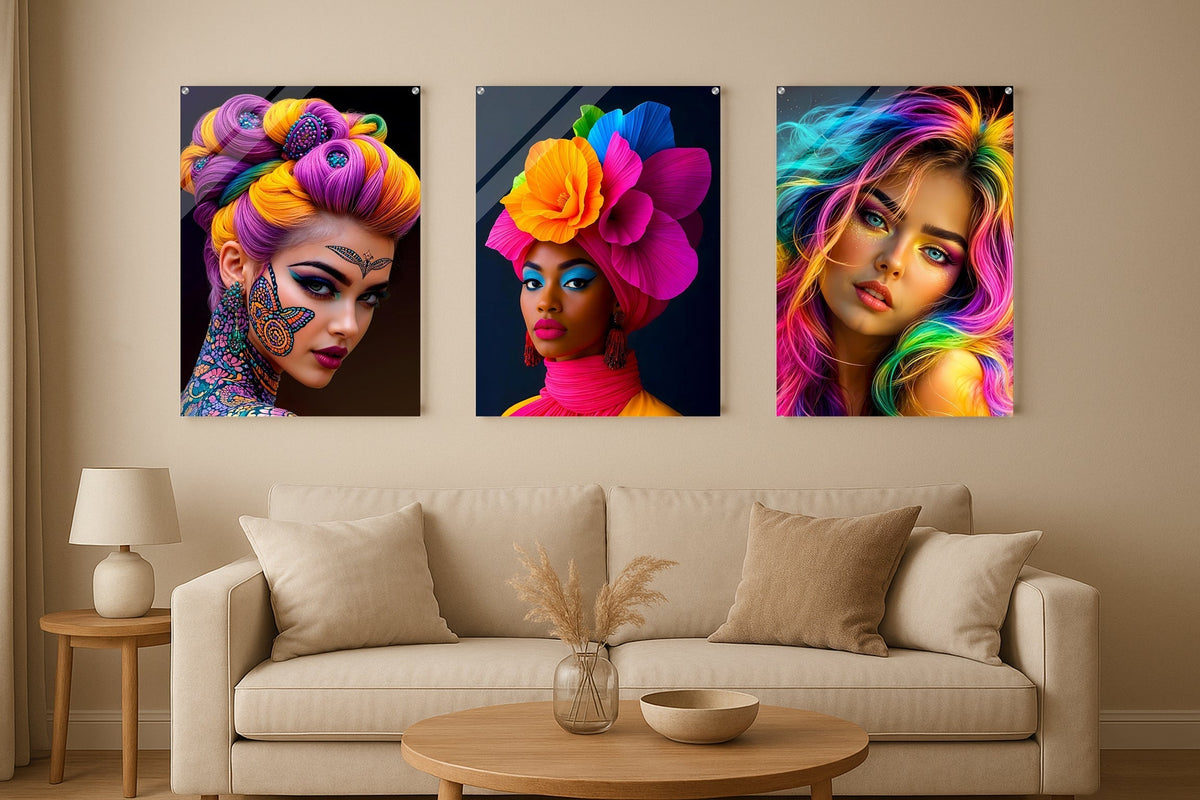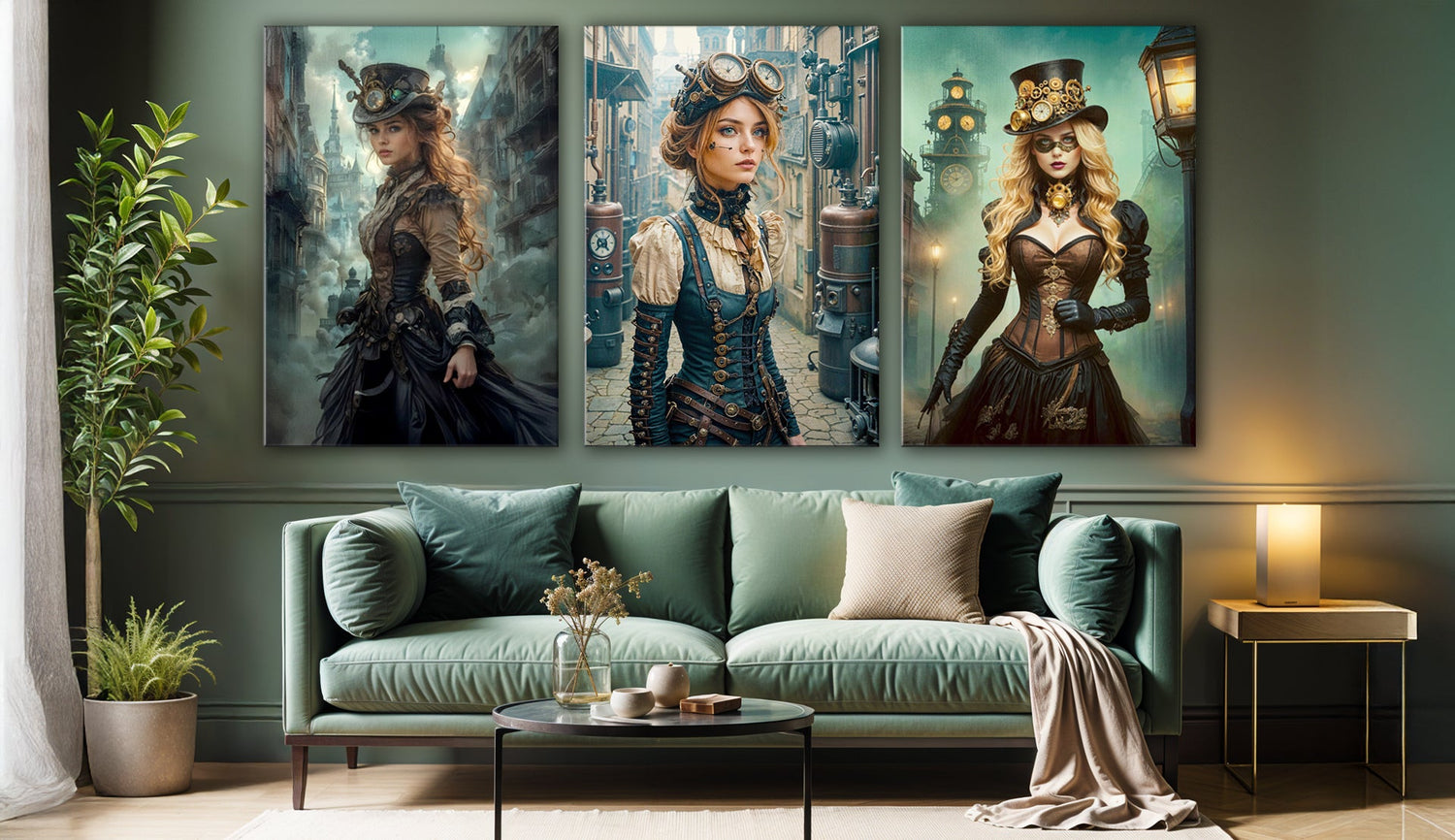
A Symphony of Color: Why Three Acrylic Prints Can Change the Way a Room Feels
Walk into almost any modern home, and you’ll notice that the walls, despite their expanse, are often left bare or decorated with something safe and predictable. Neutral tones, a framed landscape, maybe a reproduction of a famous painting. They serve their purpose, but they rarely stir much feeling. Now picture instead a wall that greets you with a rush of saturated color, with faces that seem to look back at you, and with light catching on a glossy surface so the images seem alive. That, in essence, is what a coordinated set of three colorful acrylic wall prints might bring to a space.
More Than Decoration
It is often said that one strong artwork can anchor a room, and perhaps there’s truth to that. Yet when three pieces are designed to be in dialogue, the effect is rarely static. The Vibrant Tattooed Woman, the Rainbow Woman Portrait, and the Rainbow Hair Girl do not simply sit on a wall; together, they carry the eye across, back, and again. Acrylic has a way of heightening the drama, almost like looking into a pane of glass that refuses to let the colors dull.
Some homeowners worry that such intensity could overwhelm a calm interior. And indeed, if you lean toward a pared-down, all-beige palette, this set may feel too assertive. But for those who crave atmosphere, they can shift a room from pleasant to unforgettable.
How Color Alters Atmosphere
Consider how natural light moves through a living space. In the morning, it is softer, angled, and sometimes cold. In the evening, it turns warmer, casting shadows. Acrylic wall art seems to respond to these changes, amplifying vibrancy in daylight and deepening contrasts at night. That’s part of the reason people turn to colorful wall art when they want their home to feel less like a showroom and more like a place that holds energy.
Placed above a sofa, the three portraits might create a rhythm that feels conversational, as if the figures themselves belong to the room. Over a bed, they carry a more intimate tone, their color almost seeping into the quiet of the space. Even in a bathroom—where artwork often feels like an afterthought—the glossy finish resists humidity and introduces a spark where one least expects it.
Rethinking the Arrangement
Most people hang three prints in a neat row and call it a day. While there’s nothing wrong with tradition, the truth is, such an arrangement may not always take advantage of their potential. A vertical stack, for example, works surprisingly well in narrow places like beside a doorway. A diagonal layout introduces movement, softening the rigidity of a standard wall. And sometimes separating the trio—placing one in the hallway, one in the bedroom, and one in the office—allows a subtle thread to run through a home, as if each piece were a chapter of the same story.

A Hypothetical Moment
Imagine moving into a new apartment. The furniture fits, the walls are painted, yet something feels unfinished. You try a rug, perhaps a vase of flowers, but the room still feels temporary, as if you haven’t really settled in. The day you hang a set of vibrant acrylic prints, though, something shifts. The colors reflect in the glass of your windows, the figures seem to claim the space, and for the first time you feel that unmistakable sense of belonging. It is not that art alone defines home, but it does have a way of whispering that the space has purpose.
Why Acrylic Matters
People sometimes ask why acrylic prints have grown so popular when canvas or paper still dominates the market. The answer seems to lie partly in perception. Acrylic, with its glass-like clarity, appears more contemporary. The finish protects the image, resists fading, and holds up in spaces where canvas might feel fragile. It is not always the right medium—for those who crave a matte, tactile surface, acrylic can appear too polished—but for work built on bold color, it enhances rather than diminishes.
Portraits That Invite Reflection
Portraiture differs from landscapes or abstracts. It requires engagement. The Tattooed Woman's gaze carries as much defiance as beauty, her skin adorned with intricate designs. The Rainbow Woman, adorned with a floral headpiece, exudes both regality and softness. The Rainbow Hair Girl, with her luminous locks and contemplative expression, appears both present and unreachable.
They focus on transformation, not realism. Identity is layered, and beauty can be constructed like a painting. Whether you view them as fashion, fantasy, or cultural symbolism, they inspire contemplation, a quality not common to all modern wall art.
The Question of Fit
Of course, no artwork suits every interior. If your taste leans toward minimalism, this set may clash with the restraint of your color scheme. Some say the color takes attention away from other design elements, but the trio thrives for those who embrace contrast. Rather than competing with furniture, it can anchor the room, becoming its visual heart.
A Subtle Invitation
Perhaps the strongest argument for these prints lies not in their specifications—eighteen sizes, glossy finish, durable surface—but in the way they alter daily experience. They make walls less passive. They invite conversation. They shift how light behaves. In short, they bring a pulse.
If you find yourself glancing around your own home and sensing that something is missing, these three portraits from our Colorful Acrylic Prints Collection might be worth considering. Not because they will guarantee beauty, but because they might, in the right space, give your walls a voice.







